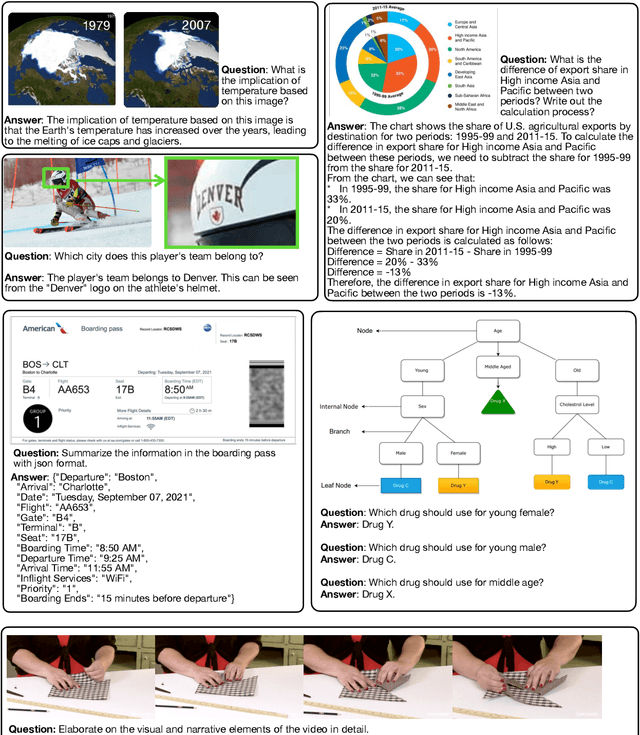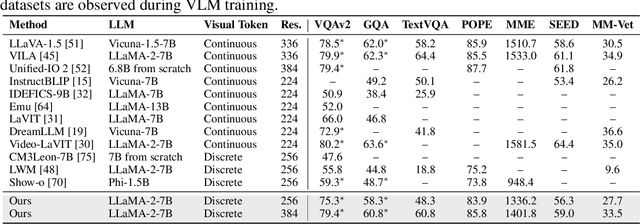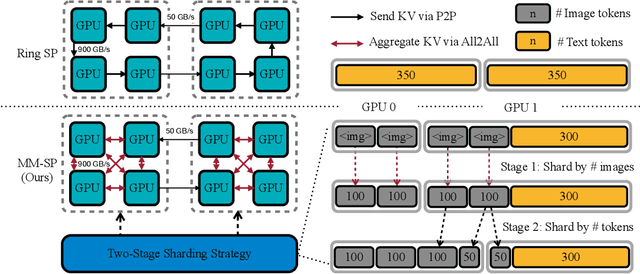Yunhao Fang
WorldModelBench: Judging Video Generation Models As World Models
Feb 28, 2025Abstract:Video generation models have rapidly progressed, positioning themselves as video world models capable of supporting decision-making applications like robotics and autonomous driving. However, current benchmarks fail to rigorously evaluate these claims, focusing only on general video quality, ignoring important factors to world models such as physics adherence. To bridge this gap, we propose WorldModelBench, a benchmark designed to evaluate the world modeling capabilities of video generation models in application-driven domains. WorldModelBench offers two key advantages: (1) Against to nuanced world modeling violations: By incorporating instruction-following and physics-adherence dimensions, WorldModelBench detects subtle violations, such as irregular changes in object size that breach the mass conservation law - issues overlooked by prior benchmarks. (2) Aligned with large-scale human preferences: We crowd-source 67K human labels to accurately measure 14 frontier models. Using our high-quality human labels, we further fine-tune an accurate judger to automate the evaluation procedure, achieving 8.6% higher average accuracy in predicting world modeling violations than GPT-4o with 2B parameters. In addition, we demonstrate that training to align human annotations by maximizing the rewards from the judger noticeably improve the world modeling capability. The website is available at https://worldmodelbench-team.github.io.
Policy Decorator: Model-Agnostic Online Refinement for Large Policy Model
Dec 18, 2024



Abstract:Recent advancements in robot learning have used imitation learning with large models and extensive demonstrations to develop effective policies. However, these models are often limited by the quantity, quality, and diversity of demonstrations. This paper explores improving offline-trained imitation learning models through online interactions with the environment. We introduce Policy Decorator, which uses a model-agnostic residual policy to refine large imitation learning models during online interactions. By implementing controlled exploration strategies, Policy Decorator enables stable, sample-efficient online learning. Our evaluation spans eight tasks across two benchmarks-ManiSkill and Adroit-and involves two state-of-the-art imitation learning models (Behavior Transformer and Diffusion Policy). The results show Policy Decorator effectively improves the offline-trained policies and preserves the smooth motion of imitation learning models, avoiding the erratic behaviors of pure RL policies. See our project page (https://policydecorator.github.io) for videos.
NVILA: Efficient Frontier Visual Language Models
Dec 05, 2024



Abstract:Visual language models (VLMs) have made significant advances in accuracy in recent years. However, their efficiency has received much less attention. This paper introduces NVILA, a family of open VLMs designed to optimize both efficiency and accuracy. Building on top of VILA, we improve its model architecture by first scaling up the spatial and temporal resolutions, and then compressing visual tokens. This "scale-then-compress" approach enables NVILA to efficiently process high-resolution images and long videos. We also conduct a systematic investigation to enhance the efficiency of NVILA throughout its entire lifecycle, from training and fine-tuning to deployment. NVILA matches or surpasses the accuracy of many leading open and proprietary VLMs across a wide range of image and video benchmarks. At the same time, it reduces training costs by 4.5X, fine-tuning memory usage by 3.4X, pre-filling latency by 1.6-2.2X, and decoding latency by 1.2-2.8X. We will soon make our code and models available to facilitate reproducibility.
VILA-U: a Unified Foundation Model Integrating Visual Understanding and Generation
Sep 06, 2024



Abstract:VILA-U is a Unified foundation model that integrates Video, Image, Language understanding and generation. Traditional visual language models (VLMs) use separate modules for understanding and generating visual content, which can lead to misalignment and increased complexity. In contrast, VILA-U employs a single autoregressive next-token prediction framework for both tasks, eliminating the need for additional components like diffusion models. This approach not only simplifies the model but also achieves near state-of-the-art performance in visual language understanding and generation. The success of VILA-U is attributed to two main factors: the unified vision tower that aligns discrete visual tokens with textual inputs during pretraining, which enhances visual perception, and autoregressive image generation can achieve similar quality as diffusion models with high-quality dataset. This allows VILA-U to perform comparably to more complex models using a fully token-based autoregressive framework.
LongVILA: Scaling Long-Context Visual Language Models for Long Videos
Aug 21, 2024



Abstract:Long-context capability is critical for multi-modal foundation models, especially for long video understanding. We introduce LongVILA, a full-stack solution for long-context visual-language models by co-designing the algorithm and system. For model training, we upgrade existing VLMs to support long video understanding by incorporating two additional stages, i.e., long context extension and long supervised fine-tuning. However, training on long video is computationally and memory intensive. We introduce the long-context Multi-Modal Sequence Parallelism (MM-SP) system that efficiently parallelizes long video training and inference, enabling 2M context length training on 256 GPUs without any gradient checkpointing. LongVILA efficiently extends the number of video frames of VILA from 8 to 1024, improving the long video captioning score from 2.00 to 3.26 (out of 5), achieving 99.5% accuracy in 1400-frame (274k context length) video needle-in-a-haystack. LongVILA-8B demonstrates consistent accuracy improvements on long videos in the VideoMME benchmark as the number of frames increases. Besides, MM-SP is 2.1x - 5.7x faster than ring sequence parallelism and 1.1x - 1.4x faster than Megatron with context parallelism + tensor parallelism. Moreover, it seamlessly integrates with Hugging Face Transformers.
$VILA^2$: VILA Augmented VILA
Jul 24, 2024Abstract:Visual language models (VLMs) have rapidly progressed, driven by the success of large language models (LLMs). While model architectures and training infrastructures advance rapidly, data curation remains under-explored. When data quantity and quality become a bottleneck, existing work either directly crawls more raw data from the Internet that does not have a guarantee of data quality or distills from black-box commercial models (e.g., GPT-4V / Gemini) causing the performance upper bounded by that model. In this work, we introduce a novel approach that includes a self-augment step and a specialist-augment step to iteratively improve data quality and model performance. In the self-augment step, a VLM recaptions its own pretraining data to enhance data quality, and then retrains from scratch using this refined dataset to improve model performance. This process can iterate for several rounds. Once self-augmentation saturates, we employ several specialist VLMs finetuned from the self-augmented VLM with domain-specific expertise, to further infuse specialist knowledge into the generalist VLM through task-oriented recaptioning and retraining. With the combined self-augmented and specialist-augmented training, we introduce $VILA^2$ (VILA-augmented-VILA), a VLM family that consistently improves the accuracy on a wide range of tasks over prior art, and achieves new state-of-the-art results on MMMU leaderboard among open-sourced models.
PartSLIP++: Enhancing Low-Shot 3D Part Segmentation via Multi-View Instance Segmentation and Maximum Likelihood Estimation
Dec 05, 2023Abstract:Open-world 3D part segmentation is pivotal in diverse applications such as robotics and AR/VR. Traditional supervised methods often grapple with limited 3D data availability and struggle to generalize to unseen object categories. PartSLIP, a recent advancement, has made significant strides in zero- and few-shot 3D part segmentation. This is achieved by harnessing the capabilities of the 2D open-vocabulary detection module, GLIP, and introducing a heuristic method for converting and lifting multi-view 2D bounding box predictions into 3D segmentation masks. In this paper, we introduce PartSLIP++, an enhanced version designed to overcome the limitations of its predecessor. Our approach incorporates two major improvements. First, we utilize a pre-trained 2D segmentation model, SAM, to produce pixel-wise 2D segmentations, yielding more precise and accurate annotations than the 2D bounding boxes used in PartSLIP. Second, PartSLIP++ replaces the heuristic 3D conversion process with an innovative modified Expectation-Maximization algorithm. This algorithm conceptualizes 3D instance segmentation as unobserved latent variables, and then iteratively refines them through an alternating process of 2D-3D matching and optimization with gradient descent. Through extensive evaluations, we show that PartSLIP++ demonstrates better performance over PartSLIP in both low-shot 3D semantic and instance-based object part segmentation tasks. Code released at https://github.com/zyc00/PartSLIP2.
Unleashing the Creative Mind: Language Model As Hierarchical Policy For Improved Exploration on Challenging Problem Solving
Nov 01, 2023



Abstract:Large Language Models (LLMs) have achieved tremendous progress, yet they still often struggle with challenging reasoning problems. Current approaches address this challenge by sampling or searching detailed and low-level reasoning chains. However, these methods are still limited in their exploration capabilities, making it challenging for correct solutions to stand out in the huge solution space. In this work, we unleash LLMs' creative potential for exploring multiple diverse problem solving strategies by framing an LLM as a hierarchical policy via in-context learning. This policy comprises of a visionary leader that proposes multiple diverse high-level problem-solving tactics as hints, accompanied by a follower that executes detailed problem-solving processes following each of the high-level instruction. The follower uses each of the leader's directives as a guide and samples multiple reasoning chains to tackle the problem, generating a solution group for each leader proposal. Additionally, we propose an effective and efficient tournament-based approach to select among these explored solution groups to reach the final answer. Our approach produces meaningful and inspiring hints, enhances problem-solving strategy exploration, and improves the final answer accuracy on challenging problems in the MATH dataset. Code will be released at https://github.com/lz1oceani/LLM-As-Hierarchical-Policy.
Distilling Large Vision-Language Model with Out-of-Distribution Generalizability
Jul 19, 2023Abstract:Large vision-language models have achieved outstanding performance, but their size and computational requirements make their deployment on resource-constrained devices and time-sensitive tasks impractical. Model distillation, the process of creating smaller, faster models that maintain the performance of larger models, is a promising direction towards the solution. This paper investigates the distillation of visual representations in large teacher vision-language models into lightweight student models using a small- or mid-scale dataset. Notably, this study focuses on open-vocabulary out-of-distribution (OOD) generalization, a challenging problem that has been overlooked in previous model distillation literature. We propose two principles from vision and language modality perspectives to enhance student's OOD generalization: (1) by better imitating teacher's visual representation space, and carefully promoting better coherence in vision-language alignment with the teacher; (2) by enriching the teacher's language representations with informative and finegrained semantic attributes to effectively distinguish between different labels. We propose several metrics and conduct extensive experiments to investigate their techniques. The results demonstrate significant improvements in zero-shot and few-shot student performance on open-vocabulary out-of-distribution classification, highlighting the effectiveness of our proposed approaches. Code released at https://github.com/xuanlinli17/large_vlm_distillation_ood
Deductive Verification of Chain-of-Thought Reasoning
Jun 07, 2023



Abstract:Large Language Models (LLMs) significantly benefit from Chain-of-Thought (CoT) prompting in performing various reasoning tasks. While CoT allows models to produce more comprehensive reasoning processes, its emphasis on intermediate reasoning steps can inadvertently introduce hallucinations and accumulated errors, thereby limiting models' ability to solve complex reasoning tasks. Inspired by how humans engage in careful and meticulous deductive logical reasoning processes to solve tasks, we seek to enable language models to perform explicit and rigorous deductive reasoning, and also ensure the trustworthiness of their reasoning process through self-verification. However, directly verifying the validity of an entire deductive reasoning process is challenging, even with advanced models like ChatGPT. In light of this, we propose to decompose a reasoning verification process into a series of step-by-step subprocesses, each only receiving their necessary context and premises. To facilitate this procedure, we propose Natural Program, a natural language-based deductive reasoning format. Our approach enables models to generate precise reasoning steps where subsequent steps are more rigorously grounded on prior steps. It also empowers language models to carry out reasoning self-verification in a step-by-step manner. By integrating this verification process into each deductive reasoning stage, we significantly enhance the rigor and trustfulness of generated reasoning steps. Along this process, we also improve the answer correctness on complex reasoning tasks. Code will be released at https://github.com/lz1oceani/verify_cot.
 Add to Chrome
Add to Chrome Add to Firefox
Add to Firefox Add to Edge
Add to Edge